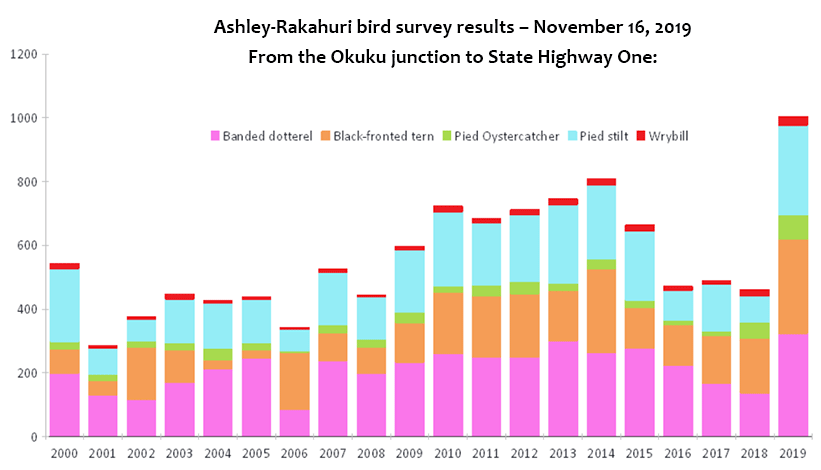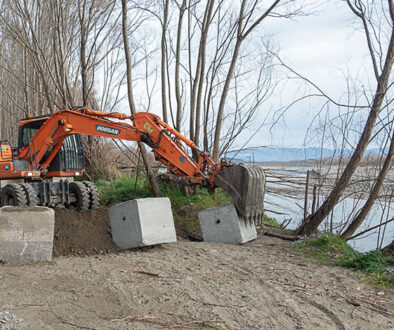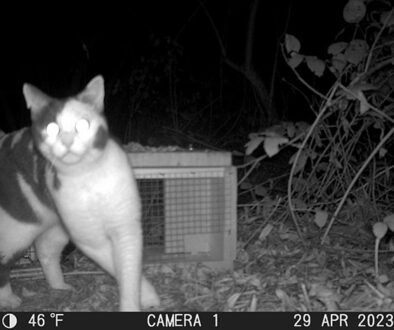Ashley-Rakahuri Rivercare Group update
Down on the river – bird numbers. Without doubt, the highlight of the last few weeks has been our annual bird survey on November 16. The Group’s mission is to improve the lot of the native birds which annually return to breed on our river, and our once-a-year surveys are the only chance to find out if we are achieving this goal. So, it was most rewarding to see 29 volunteers gathered on a fine (if windy) Saturday morning to get their survey instructions. The river flow was such that crossings were challenging, but certainly do-able, so that everyone completed their stretch and were off the river by midday. Needless to say, the survey sheets were quickly gathered and analysed, revealing that numbers for all species were the highest since we began in 2000 (see bar graph below). We saw 27 wrybill, 6 more than ever before. Thanks to there being two colonies this season, numbers of black-billed gulls (BBGs) were many-fold higher than before (over 4000). However, they are not included in the graph, as the presence or absence of a single colony, can have an over-riding influence when comparing total bird numbers from one year to the next. We reckon that the increase is mostly due to greater areas of clean shingle (less weed presence) since when bird numbers started to decline after 2014. Plus the fact that other adjacent alpine-fed rivers (such as the Waimakariri) were in full flood, forcing birds which usually occupy them to look elsewhere. This is almost certainly the case for black-billed gulls. A new species for a survey was the black-fronted dotterel (4 of them, and almost certainly breeding); a species which has been steadily increasing its range south over recent years.
Down on the river – breeding success. Determining bird populations is much easier than recording breeding success, particularly if one is trying to determine the influencing forces. This requires constant monitoring of adults and chicks, the latter often being very hard to detect. We only monitor details for wrybills, black-fronted terns (BFTs) and black-billed gulls (BBGs). At least 8 wrybill pairs took up territories, with nests found in 5. Fledged chicks have been seen in 3 of these. Four BFT colonies were located (involving possibly 80 pairs), but no chicks have yet fledged. As mentioned above, the biggest breeding increase has been with BBGs, with two large colonies (Railway and Toppings) which have numbered well over 4000 birds. The number of nests is hard to determine accurately until the sites are vacated, but it would be 1500+. Chicks are in the process of hatching, and some are just reaching the age at which they gather together in creches. It appears that some BBGs are still just arriving (late refugees from other flooded rivers?), so the fledging period may be more drawn out than usual. Good numbers of breeding pairs of other species (pied stilts, banded dotterels and S. Is pied oystercatchers) are also present on the river.
Trapping. Grant Davey sends our 27 trappers excellent monthly summaries concerning predator trapping results. Even though individual trappers may be currently experiencing a low catch rate, the overall figures for this year show that we are making an impact. Since February 1 this year, we have caught 411 predators alongside the riverbed – with rats and hedgehogs being No 1 (112 and 111), followed by weasels (77), feral cats (37) and stoats (24). Out around the estuary, the catch figures are quite different. Since we started in late June last year 344 predators were caught – with rats being at the top (168), followed by weasels (91), stoats (34), feral cats (14), hedgehogs (8) and ferrets (7). In addition to this trapping effort extending over 21 km, we have been doing more intense grid trapping around the BBG and BFT colonies – using 53 specially made, lightweight and cheaper run-through corflute tunnels, housing DOC 150 traps. The main target is Norway rats which appear to be escaping attention by living in mid-river debris piles – as they are not being caught in the berm zone where virtually all of our other traps are located. Rats can be devastating on BFTs at the egg-nest stage, and were probably responsible for the loss of 20 BFT nests at the Railway site before the offenders were trapped. Interestingly, BBGs nesting right alongside were not troubled, almost certainly because rats will not take on aggressive gulls nesting in close proximity to each other.
Weeds. As mentioned in the October Update, before the season started we cleared weeds from a number of hectares using a specially created tractor-mounted ‘undercutter/ripper’. The Railway BBG/BFT colony is occupying one of those sites. And as indicated above, the record numbers of birds counted this season, could well be responding to greater areas of clear, weed-free shingle than there was from 2014-2017. However, the threat of weed invasion is as great as ever – well indicated by the dominant lupins, which are currently flowering and colouring much of the riverbed yellow. Not so obvious are other weeds such as broom, gorse and blackberry and the equally frequent younger lupins which have yet to flower. Unless a major flood occurs before next season, or we step up our weed control efforts, then bird numbers could well decline again as the clear shingle areas become invaded. A recent inspection of the smaller foothills-fed rivers in S. Canterbury (such as the Opihi and Orari) amply reinforces this ‘beware of weeds’ message.
Human disturbance. After predators and weed invasion, the biggest threat to the future of the birds is disturbance by humans. Our awareness efforts, coupled with good signage and the physical blocking of 4WD access ways during the breeding season, means that disturbance by people and their machines is way less than it used to be. To be sure, there will always be the small percentage of people who wreck signs and go out of their way to get onto the riverbed, but there is little that we can do about them. At many of our meetings, there is vigorous discussion as to how best to increase public awareness, as it is often difficult to determine the relative cost-benefit of expenditure in this area. To this end, the Group recently formed a promotions sub-committee to work on a strategy which allows us to better plan our public awareness efforts.
The future. There is little doubt that the Group’s many years of management, primarily aimed at controlling predators, reducing human disturbance and removing weeds, has contributed to the present buoyant situation for the birds on our local river. It is equally accurate to say that we will have to continue this effort to maintain a positive situation – probably even increase it relative to weed control. In this respect, we are fortunate that over the last couple of years ECan has prioritised a step-change in its indigenous biodiversity efforts, and agreed that braided rivers be identified as a priority area for increased attention. A commitment was made to produce nine braided river plans over 10 years to 2028, and the Ashley-Rakahuri river was chosen to be one the first cabs off the rank. We are having discussions as to the form this might take, but the result should be an improved ability to ensure a better future for our local braided river birds.
Many thanks to all our volunteers for the time taken to support our cause.
Nick Ledgard
Chair, Ashley-Rakahuri Rivercare Group Inc




